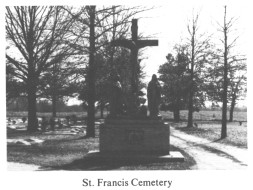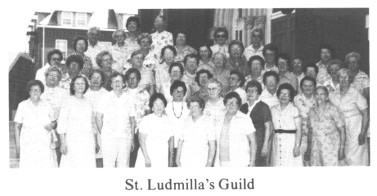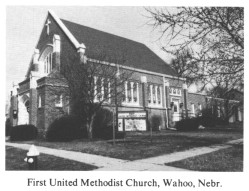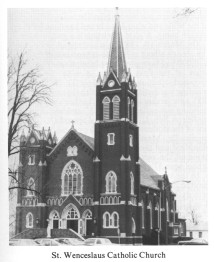 |
STOCKING PRECINCT |
|
where it had been used by Good Shepherd Lutheran congregation. While being moved from Fremont to Wahoo, a strong wind came up and blew the church partway over off its rack. Our Redeemer presently has a membership of 181 and is served by the Rev. Ralph A. Sackschewsky. It currently has members from the following communities: Wahoo, Mead, Ceresco, Colon, Valparaiso, Prague, Ithaca, Yutan, Lincoln, and Fremont. Our Redeemer is affiliated with the Lutheran Church-Missouri Synod and is one of only two LCMS congregations in Saunders County. Its current officers are: Chairman: Mr. Arthur Gottsch; Vice-Chairman: Mr. H. Joe Weyand; Secretary: Mr. Alfred Pruess; Treasurer: Mr. Michael Graf; Elders: Mr. Elmer Knapp and Mr. Lyle Christensen. It is interesting to note that Mrs. Alfred Pruess has served as organist for the congregation for its entire history. Twenty-one of the original fifty-eight chartered members are still members of Our Redeemer. Our Redeemer is dedicated to the task of preaching and teaching the Word of God in an intimate family setting and reaching out into the community to serve our fellowman in a Christ-like manner.
ST. WENCESLAUS CHURCH, |
 |
| St. Francis Cemetery |
CATHOLIC CEMETERIES
St. Francis Cemetery is located one-half mile east from the southeast edge of Wahoo, and is adjacent to the Sunrise Cemetery. The land for this cemetery was purchased for the price of $250 in 1892. The deed was not recorded until Sept. 18, 1899. The first burial was that of Margaret Rezac on July 23, 1892.
St. Wenceslaus Catholic Cemetery is located one and one-half miles northwest of Wahoo. The land for this cemetery was purchased from Mr. and Mrs. James Virgil for the sum of one dollar. The parcel of land was one acre. The purchase was made Febr. 8, 1886. The first recorded burial is that of Antonie Lanik on Nov. 16, 1879.
 |
| St. Ludmilla's Guild |
ST. LUDMILLA'S GUILD
In the winter of March 4, 1915 a few ladies met at the home of Mrs. Mary Fisher to organize a Czech Guild. They chose the name of St. Ludmilla because she was the grandmother of St. Wenceslaus, the patron saint of the St. Wenceslaus Catholic Church. The St. Ludmilla Guild came into being with Mrs. Mary Polak, first president, Mrs. Antonia Bor, vice-president, and Mrs. Mary Ficenec, secretary-treasurer. Other charter members were Josephine Safranek, Edith Machovec, Anna Pallat, Katherine Fejt, Katherine Kavan, Mary Vybiral, and Mary Fisher.
These ladies hold their meetings in their homes and paid 10 cents dues. They met in this manner for quite a few years, braving the bitter cold of winter and the heat of summer, but they enjoyed their monthly get-together, speaking their native Czech language.
When the new church was built in 1923, the ladies were provided with a meeting place in the church basement.
In January, 1959, Fr. Kolar asked that the Czech language be dropped and replaced with the English language since so many of the younger women could no longer speak Czech.
The Guild continues to serve for weddings, funerals, and various organizations just as they did in the past. The funds are donated to the parish for special needs.
In 1965, the Guild celebrated their 50-year anniversary. Officers in 1982 are: President, Frances Wotipka; Vice President, Margaret Meysenburg; Treasurer, Ann Simodynes; and Secretary, Rosalie Wotipka. Presently there are 66 active members, 7 Mass members, and 7 honorary members.
"The following ladies are now honorary members of the St. Ludmilla's Guild: Mrs. Ann Hruby, Mrs. Frances Malm, Mrs. Agnes Sabatka, Mrs. Agnes Vanek, Mrs. Josephine Bartek, Mrs. Frances Hajek, Mrs. Rose Swoboda."
ST. WENCESLAUS CHOIR
Prior to 1937, information about the St. Wenceslaus Choir, Wahoo was unavailable. It is known that Flora Koudele, Mary Krautil, Mayme Lanik and George Bartek were some of the organists in the early years.
The present Senior Choir was organized in 1937 by Fr. Otto Ekhaml. Members were Hilda Simodynes, organist, Theodore, Francis, Jenny, and Josie Divis, Antoinette Bratrovsky, Joe Kudrna, Matt and Angeline Havelka, Ann Bartek, and Mary Sudik. Theodore Divis and Ann Bartek are still members today. Mrs. Ray (Hilda) Simodynes has been the organist for 45 years. Other longstanding members no longer with the choir were Albert Meduna, Milo Svoboda, Bernard Chapek, and Marie Bartek, all deceased, and Ida Bartek and Wilma Wotipka.
The directors through the years were Rev. Frank Leiblinger, Rev. Wenceslaus Beranek, Rev. Adrian Herbek, Katherine Pohl, Shirley Divis, John Garner, George Volkmer, and Sue Redlin. When the old pump organ refused to play another note, an orgatron was purchased in 1940. In 1963, Msgr. Cooper had the present organ installed.
The choir spends many hours in rehearsal for special occasions. Most memorable of these special occasions were Msgr. Nemec's 25th and 50th Anniversaries of his Ordination; the 25th Anniversaries of Msgr. Cooper and Fr. Joe Mroczkowski; the Ordination and First Mass of Fr. Ray Roh; and the First Masses offered by Fathers John Ludvik, Richard Sladky, and Frank Machovec. Special music is always sung at Christmas and Easter.
Present choir members are Theodore, Rose and Carol Divis, Adrian Bartek, Rosalie Vculek, Catherine Nemecek, Helen Ludvik, Clayre Sabatka, Mildred Asmussen, Ann Bartek, Margaret Meysenburg, Dale and David Kavan, and Dave Leander. Gladys Cajka is the director and Hilda Simodynes is the organist.
ST. THERESA'S CATHOLIC
STUDY CLUB
The St. Theresa's Study Club was organized in 1932 with 25 members. It was affiliated with the National Council of Catholic Women in 1933. For many years it was the only organization in the parish affiliated with the National Council. Among the organizers and charter members were Mary St. Martin and Edith Lauvetz. Each of these women, a few years later, became President of the Lincoln
page 139
| Back | Contents | Next |
The Saunders County NEGenWeb Project


